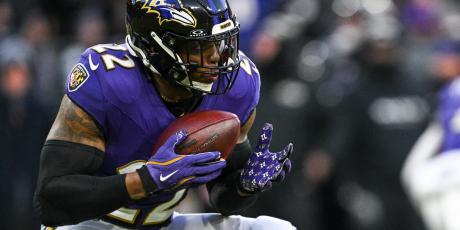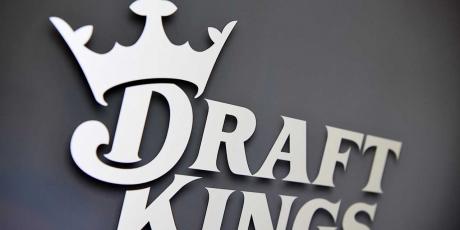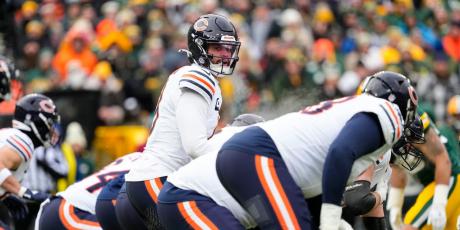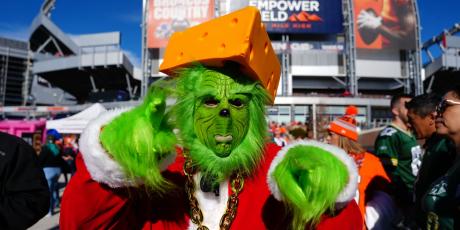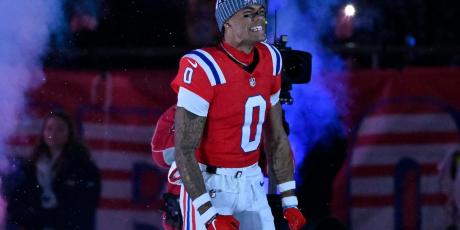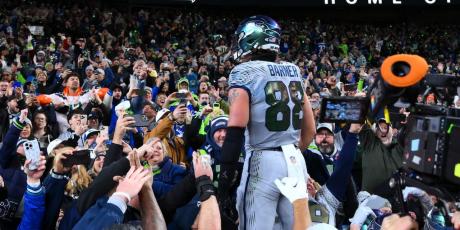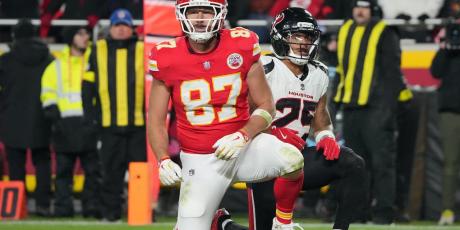5 Players Affected By Offensive Line Play in 2018
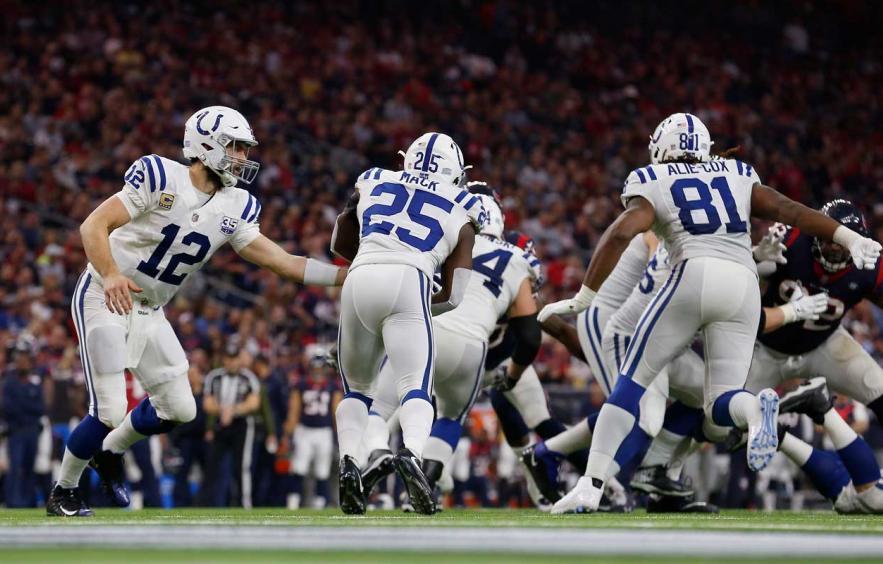
We continue our offseason look at the offensive line today by looking at which 2018 fantasy players were most affected by their line’s play. In my first article here at 4for4 I created a primer to describe the types of stats I use to create my metric to rank offensive lines. We will continue to expand on that in the coming months to help solidify rankings as we head into the 2019 season. But before we do, let’s dig through 2018 and see the impact our trench warriors had on our fantasy scores.
Running Back Scoring
Let’s talk correlation before we spotlight individual players. What can stats like Football Outsiders’ Adjusted Line Yards or Adjusted Sack Rate tell us about skill position players? A decent amount, it turns out. The scatter plot below shows every team’s 2018 PPR running back fantasy production, plotted in order of their offensive line’s Adjusted Line Yards. While this isn’t ground breaking, a 0.39 correlation does mean it’s a significant piece of the puzzle.

If we take away some of the receiving work of the running back (a section of the game that the offensive line can’t control), our numbers may look a little bit better. So, let’s remove the points per reception aspect and look at the correlation between Adjusted Line Yards and a team’s fantasy points with Standard scoring settings.

Not bad. A 0.44 correlation is an improvement, and in terms of predictiveness, it would rank as a top-10 statistic in a recent study by our own TJ Hernandez about year-to-year correlations. Clearly, this won’t be the end-all, be-all of stats as you look at 2019 drafts but this shows that an offensive line creating movement at the point of attack is a positive for fantasy running backs.
Quarterback Scoring
Another nifty Football Outsiders stat, Adjusted Sack Rate (ASR), considers how often a team passes and adjusts the raw sack count while factoring in opponent quality, as well as down and distance. A lower sack rate and a higher ranking in ASR mean more sustained drives and higher fantasy points. For example, the top three teams in ASR were New England, New Orleans and Indianapolis. Three sufficient offenses.
The following graphic shows the six teams who jumped at least ten spots in ASR from 2017 to 2018. The data next to the team name is each team’s fantasy points per pass attempt (FP/ATT) from 2017 and from 2018.
| Team, # of spots | 2017 FP/Att | 2018 FP/Att |
|---|---|---|
| Patriots, 12 spots | 0.61 | 0.58 |
| Colts, 31 spots | 0.43 | 0.60 |
| Chiefs, 11 spots | 0.59 | 0.78 |
| Bears, 16 spots | 0.41 | 0.57 |
| Panthers, 10 spots | 0.50 | 0.55 |
| Broncos, 18 spots | 0.46 | 0.45 |
| Average | 0.50 | 0.59 |
This group of teams averaged 0.08 more fantasy points per pass thrown in 2018 than 2017. That doesn’t sound like much but take into account the average NFL team throws the ball 552 times a year. Over 16 games that would equal 44+ fantasy points, or, the gap between the QB10 and the QB18.
Now that we’ve described how a couple of these stats actually make a difference in our fantasy world, let’s run through some guys who were buoyed or drowned by their offensive line.
David Njoku
2018 Finish: TE9
Njoku was thankfully pulled off special teams in 2018 and thus saw 100% of his usage (871 snaps) as a member of the offense. The uptick in routes run was accompanied by a large increase in In-line snaps and a smaller percentage of his routes run from the slot or out wide. Cleveland’s strong interior offensive line performance was muddled with a below-average pass protecting tackle group that forced the Browns hands into keeping a tight end as a part of the formation to allow Baker Mayfield to remain upright.
Njoku’s freakish athletic ability is often on display, reminding everyone why we want shares of his namesake in all our fantasy teams. The volume never quite got there last season and his 7.2 fantasy points per game had him finish off the season as the TE15 amongst tight ends who played at least eight games. He and all other offensive weapons in Cleveland would benefit from the Browns adding another piece at the tackle position to allow the 6’4”, 246-pound tight end to roam free in the defensive backfield more often in 2019.
Marlon Mack
2018 Finish: RB21 (12 Games played)
The biggest beneficiary of the revamped Indianapolis Colts offensive line was sophomore running back Marlon Mack. After a less than stellar rookie season and the drafting of two backs who were thought to be ready to supplant (Nyheim Hines and Jordan Wilkins), Mack performed like very few had the foresight to predict. Returning in Week 6 from injury, he finished off the season averaging nearly 20 touches a game and ended 2018 as the RB11 in fantasy points per game.
Indianapolis doubled down on offensive linemen in the first two rounds of the draft and it paid in spades. Quenton Nelson (left guard - first round) and Braden Smith (guard, converted to right tackle – second round) each logged at least 12 starts and shored up an O-Line that was reeling after 2017.
| Player | Rushing Yards | Yards Per Touch* | Fantasy Points (0.5 PPR) | FPts/G |
|---|---|---|---|---|
| 2017 Marlon Mack | 358 | 5.10 | 92.8 | 6.60 |
| 2017 Colts Backfield | 1,391 | 4.34 | 275.7 | 17.23 |
| 2018 Marlon Mack | 908 | 4.76 | 169.6 | 14.40 |
| 2018 Colts Backfield | 1,581 | 4.93 | 358.2 | 22.38 |
*catches + carries
You can see in the graphic above how much Marlon Mack and the entire Colts backfield improved across the board. Mack’s per-touch average dropped from the previous year but that’s simply because he lost some passing game usage to Nyheim Hines; Mack actually raised his yards per carry from 3.8 to 4.7. The sophomore season ended with five 100-yard games (including playoffs) and eleven trips into the end zone. With this shining endorsement from GM Chris Ballard, we can once again look forward to seeing him “carrying the load” for this powerful offense in 2019.
Mitchell Trubisky
2018 Finish: QB15
Like Marlon Mack, quarterback Mitchell Trubisky is another sophomore player who took a big leap as a fantasy piece behind an improved offensive line. As mentioned at the beginning of this article, the Chicago Bears were one of six teams who jumped at least ten spots in Adjusted Sack Rate. The lack of a collapsing pocket helped to catapult Trubisky into fantasy relevance after a disappointing rookie season, one in which he scored 14.5 fantasy points per game (identical to teammate Mike Glennon), ranking him as QB37 and sparking questions about the quarterback’s legitimacy as a real football and fantasy football asset.
Scheme and an incredibly disciplined offensive line (Chicago’s 22 O-Line penalties ranked fourth-lowest in the NFL) supported Trubisky’s 2018 breakout and helped to deliver boom weeks of 30+ fantasy points on four different occasions. With boom weeks, came a collection of busts, as well. His questionable decision making continues to plague his overall production but should also put him firmly on our best-ball radar. Trubisky is the only quarterback in the league that ranked top-seven in Next Gen Stats’ Air Yards to the Sticks and Aggressiveness%, indicating he is attempting passes past the first down marker and into tight coverage with regularity.
It remains to be seen if Mitchell—don’t call me Mitch—Trubisky will continue his maturation in his third season of NFL play but his aggressiveness and a stout offensive line gave us a great surprise during his second.
Deshaun Watson
2018 Finish: QB5
Prior to our first article on offensive line play, I created a metric weighting seven statistics I felt had the best chance of predicting future fantasy success for the skill players of each team. I chopped the numbers into a nice manageable one-to-thirty scale and assessed each team their value. The Houston Texans earned a 22.38, which means absolutely nothing out of context. It just so happens that “22.38” is the worst score out of all 32 teams, worse than the rest of the bottom-five which includes the Jacksonville Jaguars, the Miami Dolphins, the Washington Redskins and the Buffalo Bills.
What differentiates the Texans from each of those teams is the high fantasy scoring seasons that Houston produced. Deshaun Watson (QB5), Lamar Miller (RB22), Will Fuller (WR21 in PPG – only played 7 games) and DeAndre Hopkins (WR1) were all good to phenomenal fantasy assets in 2018. This was all accomplished behind the least experienced offensive line in the league giving up the most amount of quarterback hits (126).
Slight (or severe) upgrades across the frontline could put Watson in the conversation to be 2019’s overall QB1, but he could also do the team a favor and work on speeding up his decision making—he held on to the ball at the second-highest rate in the NFL. The signing of Matt Kalil is a good sign for depth and experience but they still need to spend some premium picks on the offensive line if we’re ever going to see the true ceiling of the Houston offense.
Joe Mixon
2018 Finish: RB10 (14 games played)
Joe Mixon was another player who flew in the face of his own offensive line, finishing as a top-ten fantasy running back despite missing two games and running into brick walls. He finished in the top-five in rushing yards, 1st downs gained and runs of 10+ yards. All the while Cincinnati was ranked 22nd in Adjusted Line Yards and 20th in FO’s Stuffed ranking with 20.1% of the Bengals runs going for zero or negative yards. In fact, 58% of Joe Mixon’s runs went for 3 or less yards while 21% of his runs went for zero or negative yards; the only players to sustain his type of output while being stuffed a similar amount were Saquon Barkley and Adrian Peterson. Pretty good company.
A great way to put in perspective how Mixon made the most of his line’s limited talent (besides just looking at his PFF grade), is to compare what he was able to accomplish in comparison to his running back mates. The first graph shown below is Mixon’s success rate over average. He was above league average even though he had a right tackle in Bobby Hart (incidentally just signed a three year/$21M contract) who couldn’t set the edge for him on sweeps and power run plays.

Fan favorite Giovani Bernard was well below league average and couldn’t survive the ravages of the interior.

Finally, you can see below how fourth round pick Mark Walton had a miserable time when he was called upon. The horror from the experience may have bled into his off-field life as he has now been cut eleven months after being drafted due to a litany of arrests.

I understand it’s probably not fair for me to compare a first-string running back with the second or third string running backs but there aren’t a lot of options when attempting to explain how impressive it is that we are seeing this type of production. The Cincinnati Bengals have been attempting to fill holes across their offensive line for what feels like a decade. Once again, if they come out of the draft with more lineman than they went into the draft with we could see this offense hum. But then again, this has been the same old song and dance since 2015 with this organization.

